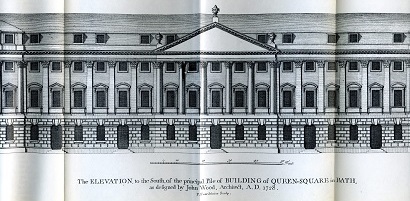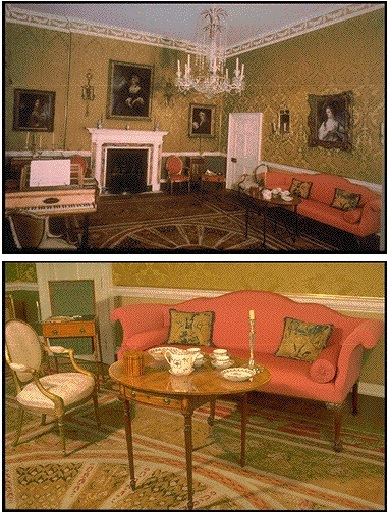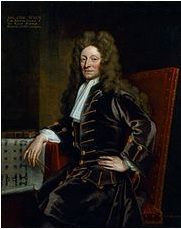ARCHITECTURE AND DOMESTIC INTERIORS: OVERVIEW
Architecture and its images
Portrait of the architect Christopher Wren by Godfrey Kneller (1711) (c) National Portrait Gallery, London
- Architecture: To familiarise yourselves with the visual structures in town design and buildings of the time, you should study topics concerning buildings and their representation.

* The architect's practice: The corresponding exercise 'The architect's brief', is presented as a 'lesson': it is a case study, in which you will learn about architecture by simulating an architect's practice, making successive choices in the building process.
* Buildings: First read the Georgian Cities website, chapters Topics/ Architecture/ Styles, and Urban design, also look at the pages on Bath - Architecture, to learn about architectural theory and practice. Pay attention to the pages on the orders of architecture, and the use of surveying tools. Also look at the portrait of the architect Wren above, serving as an introductory vignette for the present unit - a detail will be shown at the beginning of the exercise.
- The representation of buildings:
* Drawing techniques: on the Georgian Cities website, look at the pages on drawing techniques, such as perspective (Topics/Architecture/Urban design/Perspective methods). Study the interaction between landscape drawing/townscape drawing: landscape drawing tools dating from the Renaissance were used for several centuries, serving primarily to frame the view, and this contributed to the perception of space and landscapes (Topics/Culture and the arts/Painting).
* Architecture and painting: on the National Gallery website, look at the website for the exhibition 'Building the Picture' (Summer 2014), which focuses on 'how architecture forms the basis of many Italian Renaissance paintings.' The exhibition contained:- images and essays on topics such as 'Constructing the Picture/ Putting perspective into perspective' and 'Place Making/Between real and imagined places'- films showing how contemporary media, such as the cinema and videogames in virtual reality, interpret architectural space, suggesting comparisons between artistic representations of architecture in the Renaissance and now.
* Present-day images of Georgian architecture: a topic discussed in the last questions, guidelines will be given in the introduction to the questions.
Period-house museums and e-museums:
We shall now study the domestic interiors of Georgian houses; in several cities, we now have museums of daily life which are houses of past centuries furnished in historic style; we shall explore several of them. We also have web simulations of such houses, e-museums.
- Period museums: houses furnished in a style of the past, attempting to recreate the surroundings of daily life in a past century.
* Actual or typical rooms? The curators complete the decoration of the room as it was at the time, from documents; they keep or acquire objects which sometimes were actually in the rooms, but in many cases which are of the same period though they actually come from other houses - so they reconstruct the room 'as it might have been' as a typical room of the time.
* Our interpretation:
- Present-day scholarship: Such museums reflect the current state of historical scholarship, they may change.
- Changes over time: They also take into account social habits of the time concerning the uses of rooms and social practices - the purposes of rooms have changed over the centuries, see the 'parlour'. For a house that has existed for centuries, they have to choose one period for reconstruction.
- The present: As with other historical buildings, they are also submitted to present-day regulations - such as safety regulations for exits. - e-buildings: recreations in electronic media now interact with real life museums
*VR (virtual reality models in 3D) , panoramas in 360°, for study use
* apps to be used on location, combining real and virtual environments - Interior views and views towards the distance:
* interiors of the past already contained openings towards distant or imaginary places: views from the windows, landscape paintings, objects from other countries. Look for them in the period houses or their websites.
* in the 'rus in urbe' urban design from the late 18th century onwards ('country in the city'), rows of houses faced landscaped areas and had views towards the countryside.

Rollover the image to alternate between two interpretations of the 'withdrawing room' (or 'drawing room') at 'N°1 Royal Crescent' in Bath.
On the Georgian Cities website, study the chapters on the period houses 'N°1 Royal Crescent' in Bath, and the links to similar houses in other towns, especially from the page Topics/Society: Daily Life and Leisure. You will learn the relevant vocabulary concerning Georgian furniture.
